Spinel Gemstone Buying Guide
Red Spinels and Rubies were the same
Spinels are the most under-appreciated gemstone of the 20th century. Little was known about them until 1783 when a French mineralogist Jean Baptiste Louis Rome de Lisle differentiated Spinel from the corundum(Ruby) family. Before then, red spinels were mistaken as rubies because of the striking similarity in beauty and appearance. Famous rubies in history such as The Black Prince's Ruby and Timur Ruby were later tested to be red spinels. Spinels comes in all shades of colour expect pure green and yellow. Even though the demand for spinel have picked up significantly in the recent years, the general public have little knowledge about the beauty of this gemstone which fortunately for some, still makes it quite affordable. The mineral itself is very durable, it has a hardness of 8 and is higher than garnet or tourmaline which makes it a great alternative gemstone for engagement rings. Consumers also need not have to worry about treatments and enhancement like with rubies and sapphires because spinels are generally not treated. Browse our collection of Natural Burmese spinels or learn more about the gemstone's facts, pricing, history and identification in the spinel buying guide below.
Synthetic Spinels
Synthetic spinels made from the Verneuil flame-fusion method are widely available in abundance at a low cost. It can be produced in a range of colours; some of which are not found in a natural spinel such as green or yellow. Some colourless spinels can be found in nature although they are very rare. Synthetic spinels are mainly used as imitations for other gemstones of value but also used to imitate as their natural counterpart. Colourless ones can imitate diamonds and red ones for ruby as an example. Synthetic spinels have been grown by the flux method but are not commercially available. Identifying a synthetic spinel can be performed by a trained gemologist through the use of standard gemological instruments.
Spinel Quality Factors
Just like the 4Cs of a diamond, rubies also have a similar grading system but with more complexity. They have the standard 4Cs: Colour, Clarity, Carat, Cut, plus origin and treatments. The latter two are also relevant with diamonds but not considered as important as in Rubies.
Colour
Colour is the most important factor in spinels. Some colours are much are more rarer and commands a higher premium. Spinels comes in all colours except for pure green and yellow. The most important colour of spinel being vivid red which resembles the same pigeon blood red of a Burmese ruby. Cornflower blue follows next being equally scarce. Then, the brightly coloured pinks(Jedi, Hot Pink), purples(Lavender, Lilac), orange and greys. Popular colours and their origins are discussed further in the renown colours section.
Colour: Saturation and Tone
It’s important to understand the saturation and the tone of a spinel because it can affect the value greatly. As an example, a red spine that is well saturated in colour but has a dark tone is one tenth of a price of the same saturated red stone but is medium tone. A lesser saturated red become pink in colour and also has a different value to the more saturated reds. Saturation refers to the amount of colour that’s in a gemstone while the tone indicates the lightness(Light, Medium, Deep) of a stone. As a general rule of thumb, dark toned spinels are more common and considered less in value.
Cause of Colour in Spinels
Spinel is an allochromatic gemstone which means that the colour in it is caused by trace impurities. Spinel in its pure chemical composition is colourless, however, this is very rarely found in nature. The most common trace elements that gives spinel its colours are chromium, cobalt and iron. Chromium causes red and cobalt(with iron) causes blue.

Clarity
Natural gemstones are susceptible to inclusions and spinel is no exception. Spinel that are free of inclusion to the naked eye are worth more than ones with visible inclusion. The value decreases with the amount of inclusions that are present within the stone. These inclusions can be in the form of crystals, negative crystals, fractures and healed fractures.
Carat
Faceted spinels can be found in large sizes upwards of 100 carats but are extremely rare. Very few are known to exist in these sizes and belong as polished roughs on the crown jewels of monarchs around the world. Any spinel above 5 carats are rare, especially in the Red and bright Pinks. Sizes upto 2 carats are common and readily available in any colour. Above 3 carats spinels are becoming less common and prices can hike up dramatically from here. Fancy coloured spinels upto 10 carats can be found without too much difficulty.
Cut
Spinel are usually cut to the shape of the what the rough would permit to retain weight and minimise waste. In the case of water-worn pebbles, ovals or rounds shapes are most suitable. Octahedral crystals are normally cut into square cushions. The cut on the spinel is important in determining the overall value of the stone because some spinels are cut to maximise weight retention without any consideration for the brilliance of the gem.
Origin
Origin is an important factor when it comes to fine quality spinels not so much with the fancy colours. Certain colours such as the Burmese Vivid Red, Namya and Jedi can only be found in Burma. 'Colbaltain' spinels with a hint of zinc from Sri Lanka. Finally, the cornflower blue from Vietnam. The limited availability of these 'trademark' colours from each origin adds an extra premium to the value of a spinel.
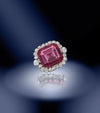
Record Breaking 'Hope' Spinel Sold in 2015
An enormous natural spinel of 50.13ct with rose hues dubbed 'The Hope Spinel' was from one of the world's great gem collection by a London banker Henry Philip Hope. A prestigious auction house, Bonhams sold the spinel at record breaking price of £962,500 on 24 September 2015.
Spinel Treatments
Although most spinels on the market are free from any forms of treatments or enhancements, heat treatment is possible. In 2012, GRS (GemResearch Swisslab) conducted an experiment on the heat treatment of Burmese spinels in Mogok which showed that heating spinels can have a slight improvement in colour by means of removing orange and brown tones and increasing colour saturation. Even though the possibility is there, the slight improvement in colour does not warrant the cost of the treatment. Hence, most spinels in the market are unheated.
Caution: Diffused Spinels
As of May 2015, there is a new form of treated blue spinels that has been injected into the market. Studies from the GRS and GIA report that these blue spinels have been diffused with cobalt and iron at high temperature to enhance light coloured spinels to a saturated blue. The treatment itself is not new to the gemstone market. Diffusion treated sapphires has been around for a few decades. This treatment follows similar techniques to add trace elements that causes colour in spinel while heating.

Cross section of a Diffused Blue Spinel
On the left, a blue spinel that has been diffusion treated. Photo on the right shows a cross section a diffusion treated spinel that has been cut in half down the middle. Significant amount of colour penetration can be observed. Image source: GIA
Renown Spinel Colors
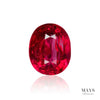
Vivid Red Spinel
Although red spinel are found else where in the world like Tanzania and Sri Lanka, they are not quite the same as the pure red, pigeon blood like red from the chromium rich deposits of Mogok. A well saturated medium tone red spinel from Burma can compete with the best quality Burmese rubies but at a more affordable price.
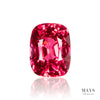
Jedi Spinel
The nickname Jedi was given to the neon bright pinkish red spinels that were originally found only in Namya, Burma. Made famous by Vicent Pardieu of the GIA Thailand, it was him who named these brightly coloured reddish pink spinels that didn't fall onto the 'dark side' (dark tones), Jedi. True Jedi spinels only come from Burma and are very hard to come by.
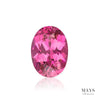
Hot Pink Spinel
A highly saturated pink spinel with a slight hint of red. Not as much as in a Jedi. This wonderfully florescent colour will capture attention amongst any crowd. They are found in most of the sources around the world but most consistently from Mahenge, Tanzania.
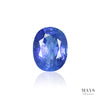
Cobalt Spinel
To achieve Cobalt spinel status, it must contain enough Cobalt to make the gem a brightly coloured blue, much like a cornflower blue colour in a blue sapphire. True Cobalt spinels are very rare and are only consistently found in Vietnam and Sri Lanka. Most blue spinels contain Iron or Zinc which given them a darker tone.
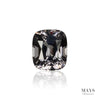
Grey Spinel
Grey spinels has been setting trend for the past couple of years. They seem to complement high jewellery with their unique colour not seen in other varieties of gemstone. Found through out the world but most consistently from Burma and Sri Lanka.
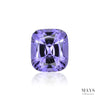
Lavender Spinel
Another semi-unique colour to spinel not quite like any other gemstone if the saturation and tone is just right. True lavender colour is unlike that of an Amethyst in that it leans more towards the blue hues. A redder variation called a lilac spinel is equally attractive.
Spinel Crystals
Spinel belongs to the cubic crystal system and usually form in the octahedral habit. Normally, there are found in alluvial (secondary) deposits as tumbled water-worn pebbles or fragments, where they have been broken down from their host rocks many thousand of years ago.
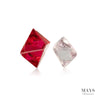
Nat Thwe
The Burmese culture accepts in the presence of the supernatural beings called 'Nats' (spirits). They are worshipped for their protection as guardians of the land. In Mogok, perfectly formed octahedral crystals of spinel with polished faces are said to have been faceted by the nats and left for the miners to be found. Hence, the term Nat Thwe which directly translates to Spirit Cut. Strangely enough, the only source of these perfect crystals are in Mogok, Burma.
Natural Spinel Price Guide 2024
The value and pricing of spinels is gauged through the above five quality factors. It’s important to consider all the factor on each stone to determine its price. Note that this is a rough price guide and does not take into account every possible factors that affects the value of spinels. Prices are is based on faceted spinels of top colour, eye clean clarity with average to excellent cut. Prices current as of 2024.
| Colour/ Origin | Carat | Price Per Carat (USD) |
|---|---|---|
| Vivid Red - Burma | 1.0 - 3.0 | $2000 - $7,000 |
| - | 3.0 - 5.0 | $7000 - $15,000 |
| - | 5.0+ | $20,000+ |
| Red | 1.0 - 5.0 | $1500 - $8,000 |
| Jedi Pink - Burma | 1.0 - 5.0 | $1500 - $8,000 |
| Hot Pink | 1.0 - 5.0 | $800 - $4,000 |
| Cobalt Blue - Vietnam | 0.8 - 2.0 | $2000 - $8,000 |
| Grey & Lavender | 1.0 - 5.0 | $150 - $2,000 |
| Fancy Colors | 1.0 - 5.0 | $100 - $2,000 |
Spinel Care and Handling
Spinel is consider a durable gemstone overall suit for everyday wear. With a hardness of 8 on the Moh's scale, it can be designed into all types of jewellery including rings. The mineral does not show any cleaving properties, although it should still be handled with care to avoid chips through impact just like any other gemstones. Below is a list of special handling instructions for jewellers.
Jeweller's Torch
Spinel is considered safe around a jeweller's torch. Avoid direct flame onto the gemstone. Higher level of caution needs to be taken when handling included spinels especially with surface reaching fractures.
Chemical
Spinels are all-round chemically resistant. Safe to be placed in a jeweller's pickle.
Ultrasonic
Care must be taken to not prolong the use of ultrasonic when cleaning included spinels. Prolonged cleaning in the ultrasonic may cause existing fractures to expand.
Steam
Spinel is safe with a steam cleaner.
Important Sources of Natural Spinel
Burma
500 AD - Current
Burmese spinels are perhaps the most well known in the world for their colour and quality. Famous colours from Burma includes: the ruby like pigeon blood vivid red colour and the vivid pinkish red colour dubbed the Jedi spinel. Burma is also known for producing perfect octahedral spinel crystals that are so well formed and polished, the locals call it ‘Nat Thwe’ which translates into cut by the spirits or angel cut. Mining operations in Mogok has been recorded in history to date back to the 6th century AD. The area has been under strict control by the different rulers of the land over time up until now. Through 1889-1931, when Burma was under the British colony, mining in Mogok was conducted by a British firm Burma Ruby Mines Ltd. Their studies showed that the highest yielding deposits would be underneath Mogok which lead to the relocation of the entire village. In 1929, prolonged monsoon rain storms flooded the mine which formed the lake in the middle of Mogok as we see it today.
Another important source(but not well known) for fluorescent hot pink spinels is located in a remote mountainous area call Namya or Nanya (aka Nanyazeik) in Kachin state, upper Burma. Mining activities only began in the late 90s and production is kept at an minimal because of the difficult terrain.
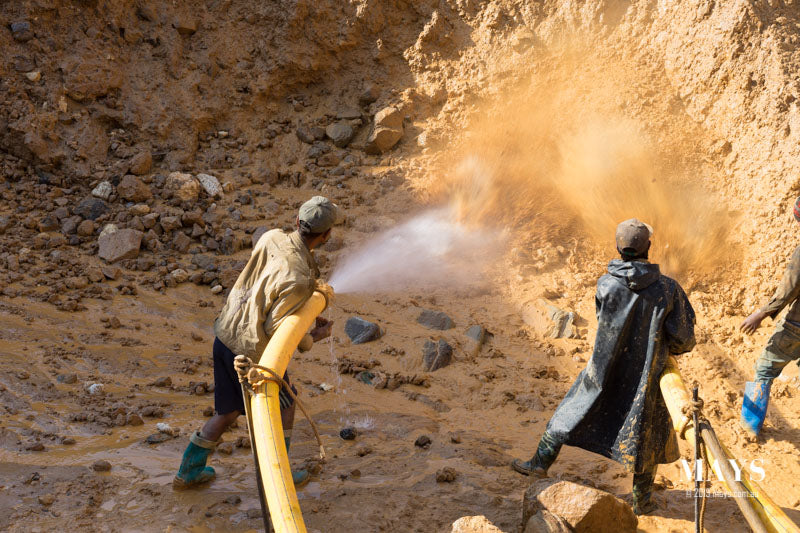 Open pit mine in Mansin, Mogok, Myanmar where miner use high pressure hoses to wash down gem bearing mountain side.
Open pit mine in Mansin, Mogok, Myanmar where miner use high pressure hoses to wash down gem bearing mountain side.
Sri Lanka
334 BC - Current
Apart for the sapphires Sri Lanka is another major source for spinels and the oldest of all current sources. Production of gems from Sri Lanka dates back to the accounts of Nearchus (a voyager from Greece) from 334 BC. Sri Lanka has been the source of blue cobalt and lavender spinels for centuries before the discovery of the Vietnamese deposits. Though its blue colour is darker compared to that of Vietnam due to the presence of zinc and iron.
Afghanistan / Tajikistan
2000s - Current
The ancient historical mines of Badakhshan (aka Kuh-i-Lal) near the border of Tajikistan and Afghanistan was the source of the world’s spinel supply over many centuries. Famous gems found in crown jewels of monarchs like the Black Prince Ruby, Timur Ruby and the spinels mounted on the Mughal Imperial necklace are thought to have been mined here. These balas ruby mining sites were believed to have been discovered after a 7th century earthquake. But due to its location being close to constant unstable political conflicts mining operations were ceased until recently in the mid 2000s after the collapse of the Soviet Union. Most spinels that comes from this area tends to be purplish pink in colour and are known to be found in large sizes with good clarity.
Tanzania
1980s - Current
Spinel deposits in Tanzania are a relatively new discovery. They were found in the 1980s along with rubies in a primary deposit near Matombo and Mahenge of the Morogoro province. Miners main focus at the time were for rubies and these spinel were collected as supplement to the budget of mining rubies. The real hunt for spinels only came in the year 2000 after local farmers found fine red spinels at Ipanko near Mahenge. In 2007, four giant spinel crystals were found in the area, one of which weighs forty four kilos. They were opaque in the center but transparent near the surface. Mahenge spinels are mostly pink in colour with their renowned colour being vibrant pinkish red.
Vietnam
1990s - Current
The newest source for fine quality cobalt blue spinels is from Vietnam. Mining operations started in the 1990s in the scenic mountainous area of Luc Yen. Arguably the best of the Cobalt spinels originates from this region through both primary marble cliff deposits and alluvial deposits. Pastel purples are also popular along with baby pink colour.
Madagascar
2000s - Current
Trademark spinel of Madagascar is blue-grey coloured. Mining operations started here after the discovery of sapphire in the late 1990s. Found together with the rubies and sapphires are these spinels.
Spinel Inclusions
The study of inclusions inside of a spinel is important for gemmologists because these minute clues can shine light on the identity of a spinel, where it came from and if it has been treated. Certain inclusions are only found from a specific source or mine site. Experts find these inclusions to pinpoint the origin of the gemstone be it natural or synthetic. There are the inclusions that are only found in spinels and never in any other gemstones. Such inclusions can be used to separate spinel from others. Finally, if the spinel has been heat treated, there are clues left behind from the heating process that can be revealed under a microscope.

Octahedral crystal inclusions inside of a red spinel from Mogok, Burma. These are typical of spinels from all sources. Sometimes, they can be negative crystal filled with another mineral such as calcite.

An elongated crystal of what appears to be an apatite inclusion. Natural crystal inclusions like this are never found in a synthetic and can be easily used to differentiate between a natural and synthetic gemstone. Grey spinel from Mogok.

A planes of minute octahedral crystals arranged in a fingerprint pattern. This are diagnostic inclusion of spinels. Grey spinel from Mogok.

A purplish pink spinel from Mogok also presented with classic fingerprint inclusions.
World's Most Expensive Spinels
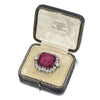
The Hope Spinel
The Hope spinel is a faceted 50.13ct pink spinel that was in the private collection of a British banker Henry Philip Hope. Before his death in 1839, his collection contained about 700 gems including the Hope Diamond, a 45.52ct blue diamond. The spinel was recently put on auction in 2015 at a London auction house and sold for £962,500 which equates to approximately 1.8M Australian dollars. It set a new record for the most price per carat spinel ever sold at auction. Explain in photo how its a pendant or brooch setup.
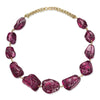
An Imperial Mughl Spinel Necklace
It’s a large spinel necklace consisting of eleven polished red spinels with a total weight of 1131.59ct. Three of which are engraved with the names of emperors from the Timurid dynasty. The spinels were tested to be of Pamir mountains origin in Tajikistan. In 2011, this necklace was sold at auction for 4,579,000 swiss francs (6.4M AUD) breaking records for most expensive spinel jewellery ever auctioned.
Historically Significant Spinels
The Samarian Spinel
The name Samarian comes from a historic biblical Hebrew city, Samaria in the central region of ancient Palestine. This spinel is known to be the largest in the world on record at 500ct. With ties to biblical tales, it may have first been found around 1000BC. Currently, it belongs in the Iranian crown jewels collection on display at the Treasury of National Jewels, Tehran, Iran.

The Great Russian Imperial Crown
The monarchs in Russia also possess a crimson red spinel which sits at the very top of the Russian Imperial Crown. It weighs 414.30ct, making it the second largest spinel in the world. Like many of the large ‘rubies’ of the time, this one also holds a story of its own filled with deceit and murder. It enter the history books around the time of the nomad King Timur when his army looted the city of Samarkand. Amongst the looters was a Chinese mercenary named Chun Li. It was him would found this enormous spinel after he was exiled into slavery at the ancient balas ruby mines because he failed to turn in some of the loot. With the stone in his hands, he made plans to gift it to the emperor of China in hopes of a handsome reward. Overnight, he escaped from the mines to return to China with the spinel. As he tried to enter the palace, a guard who found the stone stole it and killed him. The guard in turn was also killed when he tried to sell the stone to a jeweller who informed the royal palace. The spinel remained in the hands of the Chinese emperors until 1676 when emperor Kangxi sold it to Nikolai Spafari, a Russian ambassador to Beijing. Almost 100 years had passed until 1762 when the Russian empress, Catherine the Great ascended to throne that she had the spinel mounted on top of her crown.
The crown can be seen on display at the Moscow Kremlin Armoury’s State Diamond Fund.

Timur Ruby
Another significant case of misidentified rubies is the Timur Ruby which weighs in at 352.5ct and was believed to be the largest ruby in the world until 1851. The blood red coloured polished rough was found to be a red spinel. It’s named after the Persian king, Timur, who first ruled the Timurid empire across Central Asia and Persia. Inscriptions of names and dates can be found on the stone as it was passed down from each successor of the throne. In 1849 when the British colonised Punjab in India, the Timur Ruby along with the famous Koh-i-noor diamond was found together and was taken from the Lahore Treasury. The East India Company later gifted the stone to Queen Victoria in 1851. It was set into a necklace in 1853. It now remains in the private collection of Queen Elizabeth II.
Name inscriptions of Shah Jehan, the fifth Mughal emperor and his successors can be seen on the Timur Ruby along with the following statement: “This is the ruby among the twenty-five thousand jewels of the King of Kings, the Sultan Sahib Qiran (Timur).”

The Black Prince's Ruby
The Black Prince’s Ruby which currently is mounted on the Imperial State Crown of England is a red spinel despite the name ruby. It was thought to be a ruby until the discovery of a separate mineral called spinel in the late 1700s. The stone weighs approximately 170ct and is in the shape of a polished rough. The English monarchy acquired the gem as payment of war in 1367 through Edward of Woodstock (The Black Prince), when he helped defeat a rebellion against a petty king of Spain, Don Pedro. Since then, this spinel has survived through many battles being mounted on the helmets of English kings and now sits peacefully on the Queen’s crown. The spinel was probably mined from the famed Balas rubies mines of Tajikistan/Afghanistan formerly known as Badakhshan.
The Black Prince's Ruby can been seen here mounted above the Cullinan II diamond on the Imperial State Crown of England. There was once a hole drlled on to the spinel which indicates that it was worn as a pendant at some point in history. The hole has since been plugged with an actual Burmese ruby as seen in this image.
Spinel Mineral Properties
| Chemical Composition | Mg(Al2O4) Magnesium Aluminum Oxide |
|---|---|
| Hardness | 8 |
| Crystal System | Cubic |
| Transparency | Transparent – Opaque |
| Specific Gravity | 3.55 - 3.72 |
| Reflective Index | 1.712 - 1.725 |
| Birefringence | Isotropic |
| Lustre | Vitreous |
Spinel Misnomers
| Trade Name | Mineral |
|---|---|
| Balas Ruby, Spinel Ruby, Rubicelle | Red Spinel |
| Spinelle | Spinel |
| Arizona Spinel | Red Garnet |
| Candy Spinel | Almandine Garnet |

Wai Yan





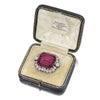





I have a Pear Shaped Opaque Black Spinel with a cut weight of 118.25Ct. Does it deserve a Name?
Am interested to Joint venture with your organization in suppling Gemstone from Kenya
Dear Mr. Ganteaume,
Thank you for bringing this to our attention. We appreciate your diligence and the correction regarding the Diamond on the Imperial State Crown. We have promptly updated our article.
Cordially,
Wai Yan
Sunday, 28 July 2024
Dear Mr Yan,
On your website you have incorrectly identified the diamond below the Black Prince’s Ruby in the Imperial State Crown of the United Kingdom as the Koh-i-noor diamond. The diamond below the Black Prince’s Ruby is the Cullinan II, or the Second Star of Africa, diamond. You may wish to correct that mistake.
Cordially yours,
Dominic Ganteaume